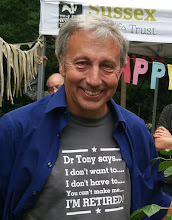You will find information about the current stage of the SE Plan on the Sussex Wildlife Trust web site, but I thought I would spend some time highlighting the size of the gap between the growth and development desires in the SE Plan versus the need for sustainability.
Even the Government’s own Sustainability Appraisal concludes that the changes now proposed by the Secretary of State will result in the environmental limits of the South East being approached and possibly even breached. These changes do not just increase the level of environmental damage associated with the Plan, but also substantially lower the quality of life of the region’s population. The Plan cannot even guarantee to protect the most important wildlife sites – those protected because of the international importance – so what hope is there for our nationally or locally important wildlife habitats?
If we look a little closer at the figures we can see the size of the problem we face.
Never mind “the environmental limits of the South East being approached”, work by the Government Office for the South East a few years ago has shown that the ecological footprint for the South East is already 29 times its physical area. That means that we need an area the size of France just to support our lifestyle.
So we already consume an area far bigger than we actually have – but we plan to grow further.
The plan has an economic growth goal of 3% per annum – very attractive in terms of our personal wealth, but what does this mean? A 3% growth rate results in a doubling time of 23 years (just longer than the life of the plan). In 23 years time our economy will be double the size that it is now and will have double the resource requirements that it has now. So, roughly by the end of the plan we will be using double the number of resources that we use now. How sustainable is that bearing in mind the ecological consequences of the resource use we have now?
The maths also draws us towards another startling conclusion. Take the period from now -2008 - to the end of that doubling period (23 years time) the year 2031. In that period we will use the same amount of resources as we have done in our entire history up until 2008. This is simply the maths of how exponential growth works.
I cannot see how some of our most cherished wildlife can survive even at the current level of human activity even if we could rely on an area the size of France to support us. How it could survive when we have double the level of activity and after using as many resources as we have used in our entire history is even more difficult to understand.
The SE Plan has good phrases about stabilising and then reducing resource use, about reducing greenhouse gas emissions and responding to climate change, about protecting wildlife and the environment. And I do believe that the people involved are sincere, honourable people who are doing their best for the region. But a 30% increase in housing numbers for Sussex (even over the huge figures already proposed), a desire for economic growth of 3% (without any real question of the nature of that growth and its effects), population increase, “infrastructure” development, water use, resource use, energy use and land taken away from nature – all severely undermine any attempt at long term sustainability. The environment is going to be negatively impacted, we are going to loose wildlife and its habitats and the lives of the people in the region are going to get worse.
Wednesday, 15 October 2008
Subscribe to:
Comments (Atom)
